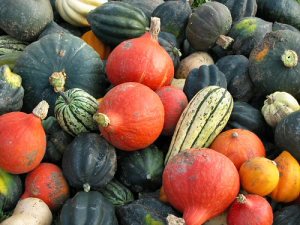 By Kathleen Harvey, Owner, Plant Artistry, LLC
By Kathleen Harvey, Owner, Plant Artistry, LLC
Squash are members of the gourd family, which fall into two broad classifications, summer squash and winter squash. Winter squash grow either round and elongated, or scalloped and pear-shaped, with flesh that ranges from golden yellow to brilliant orange. Most winter squashes are vine-type plants whose fruits are harvested when fully mature. They take longer to mature than summer squash (three months or more) and are best harvested once the cool weather of fall arrives. They can be stored for months in a cool basement, hence the name winter squash.

Pumpkins may get all the glory as Halloween Jack O’ Lanterns and Thanksgiving pies, but there are many other versatile, vividly colored, flavorful, and nutrient-packed varieties to brighten up fall and winter meals. Sweeter, denser, and more firm in texture than summer squash such as zucchini, winter squash combine well with a wide spectrum of seasonings and can be true crowd pleasers when used in soups, stews, and other dishes.
Naturally low in fat and calories, the winter squash family delivers significant nutritional benefits. For example, one cup of baked butternut squash is rich in vitamins A (from beta carotene), B6, C, and E, as well as magnesium, potassium, and manganese. Flavors are generally mild-to-sweet, so squash won’t overwhelm other ingredients and can easily be incorporated into seasonal cooking. Winter squash are also packed with antioxidants, don’t contain fat, and can be prepared sweet or savory to tickle the taste buds. The different varieties of winter squash may be substituted for each other in many squash recipes with the possible exception of spaghetti squash, which has a different texture.
Acorn squash is a mildly flavored squash that is named for its acorn-like shape. Choose one with a dull green rind; an acorn squash that’s turned orange will have tough and fibrous flesh.
Butternut squash has a slim neck and bulbous bottom that give the butternut squash its distinctive bell shape. The muted yellow-tan rind hides bright orange-yellow flesh with a relatively sweet taste. To make butternut squash easier to handle, cut the neck from the body and work with each section separately.
If your Halloween pumpkin was small and squat, chances are it was a sugar pumpkin. More than just decorative, sugar pumpkins are prized for their classic pumpkin flavor, as well as for their thick flesh-packed walls. If you’d like to try fresh instead of canned pumpkin for baking and make your own purée, reach for a sugar pumpkin.
Spaghetti squash should be baked whole. Once baked, take a fork to the inside of a cooked spaghetti squash, and you’ll understand how this variety got its name. Scraping the flesh lengthwise down the fruit produces “strings” that closely resemble spaghetti. If you’re searching for a healthy, gluten free pasta alternative, try this very mild-tasting squash. It can be used as a pasta substitute and slathered with marinara, Asian stir fry sauce, or any combination where a wheat or rice noodle would be used in a recipe.
Chances are that sugar pumpkins, acorn squash, and butternut squash are the most readily available types at local supermarkets. Others, such as spaghetti, buttercup, and red kuri are worth seeking out at farmers’ markets. Regardless of the type, to get the best quality, select winter squash that are free of blemishes and bruises, have an intact stem and feel heavy for their size.
Transform the flesh of winter squash into something sweet or savory, and you’ll know that it’s well worth the effort! Happy Thanksgiving!